Guide to Adding a Bathroom in Your Home
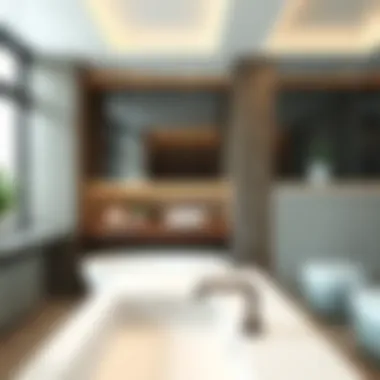

Intro
Adding a bathroom to your home can be a transformative project, adding value and convenience in equal measure. The desire for an additional bathroom often stems from the need for functionality, especially in households with multiple members. Yet, embarking on this journey is not just about picking out fixtures and floor tiles; it requires thorough planning, budgeting, and a keen eye for design. This guide aims to be your compass as you navigate the intricate process of bathroom addition, addressing every detail from inception to completion.
Whether you're looking to create a stylish guest bathroom or a luxurious master ensuite, various design inspirations can guide your choices. We will also discuss how to maintain your new space effectively, ensuring it remains in tip-top shape for years to come.
By the time you finish reading, you will not only understand the steps involved but also equip yourself with knowledge that lays a solid foundation for the successful addition of your new bathroom.
Design Inspirations
Designing a bathroom involves more than just functionality. It's also about creating a space that resonates with your personal style. From selecting tiles to choosing fixtures, the design aspect can be enriching and fulfilling if approached with intent.
Trending Styles
Contemporary bathroom designs focus on minimalism and simplicity. Think clean lines, sleek fixtures, and an absence of clutter. The popularity of rustic bathrooms has also surged, featuring reclaimed wood, exposed beams, and vintage accents. This style emphasizes comfort and natural elements, creating an inviting atmosphere.
For those who lean towards modern aesthetics, incorporating smart technology and sustainable materials can elevate your bathroom experience. Features such as smart shower systems, heated floors, and low-flow fixtures are not only eco-friendly but also enhance the functional allure of your space.
Color Palettes
Color can significantly influence the mood and feel of your bathroom. Some homeowners opt for serene hues like soft blues and greens, evoking a sense of calmness. Alternatively, bolder colors such as deep navy or rich forest green can bring a touch of drama to the mix.
Tips for choosing the right palette include:
- Consider lighting: Natural light can alter how colors appear during the day.
- Test samples: Before committing, paint patches on your wall and observe them at different times.
- Think about flow: Ensure the colors complement other adjacent rooms for a cohesive home aesthetic.
Understanding the Need for a New Bathroom
Adding a bathroom to your home can feel like a monumental task. But understanding the necessity of this addition is half the battle. It’s not just about increased convenience; it’s also about transforming the dynamics of your living space. A new bathroom can provide a sense of privacy, enhance your home’s value, and cater to your changing needs. This section aims to highlight key points regarding this essential home improvement venture.
Evaluating Your Current Bathroom Situation
Before you leap into adding another bathroom, it’s crucial to evaluate your current situation. Take a long, hard look at your existing bathrooms. How many do you have? Are there enough facilities for your family or guests? Think about daily traffic; if you find yourself waiting in line, that’s a strong indicator that an expansion is necessary.
Also, assess the condition of your current bathrooms. Are they dated or in need of repairs? A worn-out bathroom can do more than annoy users; it can also have a negative impact on the overall aura of your home. If you find yourself in the unfortunate position of sharing a cramped space where functionality gives way to stress, it’s high time to reconsider your arrangement.
"The desire for a second bathroom often evolves from practical needs to a longing for comfort and ease at home."
As you think of adding a bathroom, also consider the layout of your home. Is the space conducive to such an addition? You want to create a haven, and a well-planned layout can assist in executing that dream. A little foresight can prevent headaches down the line.
Identifying Your Reasons for Expansion
Understanding why you need a new bathroom is imperative. Perhaps you've noticed your family growing or a constant influx of guests, leading to a scenario where one bathroom simply won't cut it. In that case, having two or more bathrooms can significantly improve the quality of life.
Here are some considerations that may resonate with your situation:
- Family Dynamics: Large families often require more restroom space.
- Home Value Boost: A well-constructed bathroom can raise your property’s market price.
- Guest Convenience: If you often host friends or family, a second bathroom can be a game changer in keeping everyone comfortable.
- Improved Lifestyle: Even if you live alone, having an additional bathroom means you can create a spa-like retreat, or simply enjoy more flexibility in your daily routine.
- Renovation Synergy: Adding a bathroom can be part of a larger renovation, making the entire home feel fresh and modern.
By identifying the underlying reasons for your renovation, you’re more equipped to tailor the project to match your specific needs. Consider these motivations as you plan ahead. Each person's needs differ, and understanding your own will provide a solid foundation for the rest of this journey.
Initial Considerations
Adding a bathroom entails more than just picking out tiles and fittings. Understanding the initial considerations is crucial to ensuring the project runs smoothly. These considerations will not only help in managing expectations but also set the groundwork for successful execution later on.
Space Requirements
Space is often the biggest constraint when it comes to adding a bathroom. Before diving in, it’s key to measure the available area carefully. Are you looking at a half bath, which simply includes a toilet and a sink, or a full bath with a shower or bathtub included? Knowing this helps avoid future surprises. Make sure to consider:
- Existing plumbing: If you are near existing water and waste lines, it could save you a bundle since relocating plumbing can get quite expensive.
- Ventilation: Good airflow is indispensable to avoid issues with mold and humidity. Ensure that the chosen space can accommodate proper ventilation through windows or exhaust fans.
- Accessibility: Think about how often this bathroom will be used and by whom. Families may prioritize larger space, while guests may require something more intimate.
In an ideal situation, a bathroom should have at least 36 inches of free space in front of the toilet and sink, and around 30 inches for other fixtures. Use this guideline to assess the practicality of your space.
Choosing the Right Location
The location of your new bathroom holds significant weight. Picking a spot goes beyond simply seeing what looks good on paper; it involves real logistical considerations:
- Proximity to plumbing: As mentioned earlier, positioning your new bathroom close to existing plumbing can make life easier, both in terms of costs and installation.
- Convenience and traffic flow: You don’t want future bathroom-goers to squeeze past furniture or other rooms with high foot traffic. Location matters right down to how you navigate your home each day.
- Privacy: A bathroom that opens directly into your living area may not be the best choice. Think about creating a little distance from communal spaces.
- Natural Light: A well-lit bathroom can make a huge difference, not only in aesthetic but also in the overall feeling of space.
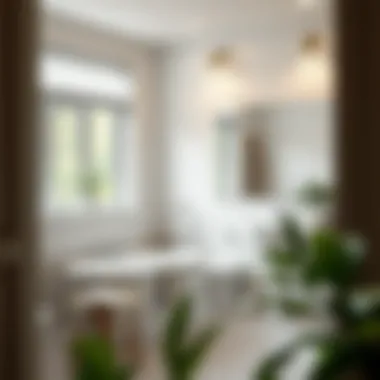
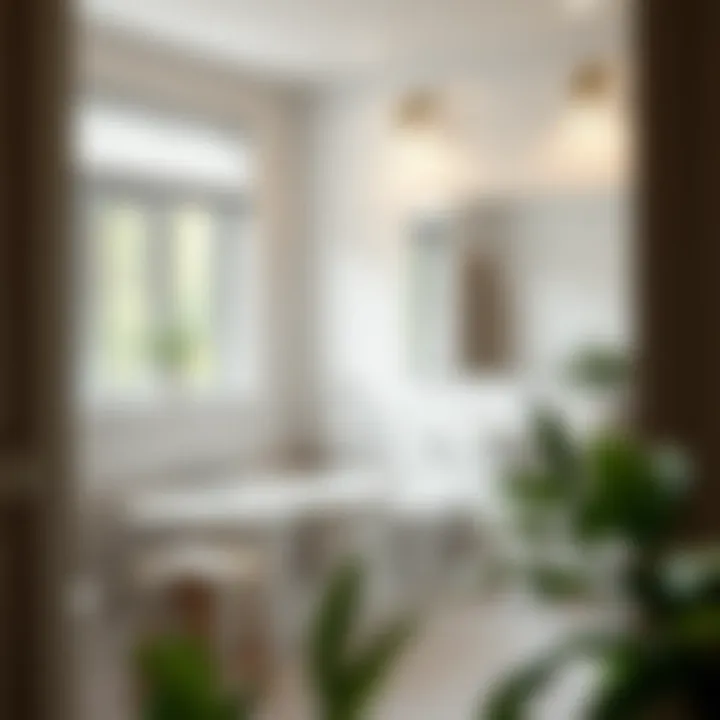
"A bathroom is a sanctuary; not just an add-on. It needs to blend functionality with a touch of coziness."
In short, understanding space requirements and location are pivotal steps before leaping into the building phase. Careful thought in these areas can save headaches down the road and lead to a bathroom that's not only functional but also a pleasure to use.
Budgeting for the Project
When taking on the task of adding a new bathroom to your home, one element becomes ever so clear: budgeting matters. It’s not just about tossing around numbers; it's about gaining insight into how much you can expect to spend and ensuring that the project fits within the overall financial plan. A well-thought-out budget allows homeowners to make informed decisions in every step of construction, from the layout to the final touches. Getting your finances in check puts you in the driver’s seat, steering past future headaches and unexpected costs.
Estimating Costs
Estimating the costs of a new bathroom can be a bit of a juggling act. Numerous factors come into play — the size of the bathroom, the quality of materials, and labor costs, to name a few.
A typical bathroom remodel may range anywhere from a few thousand dollars to well over twenty thousand, depending on choices made. Here’s a breakdown of several key considerations:
- Materials: Decide on tiles, countertops, and fixtures early on. The brands you select can calculate into your total quite a bit. Opting for a high-end sink might seem tempting, but it could mean fewer funds for other important items.
- Labor Costs: Hiring professionals is often necessary and can vary significantly by region and contractor reputation. Don’t forget to account for potential design fees, especially if you’re going with a specialized bathroom designer.
- Permits & Inspections: This can be a sneaky expense where budget-conscious homeowners may overlook. Local regulations often necessitate permits that incur fees. It's best to check what your area requires well ahead of time.
Overall, taking a comprehensive approach to estimating costs not only gives you a clearer picture of the financial investment but also alerts you to where adjustments might be necessary as you push forward with plans.
Potential Financial Pitfalls
Now that we've touched on estimating costs, let’s delve into the financial pitfalls that can trip up even the savviest of homeowners. Here are some common snags to watch out for:
- Underestimating Costs: It’s far too easy to overlook certain expenses. Whether it’s an unseen plumbing issue or an unexpected need for new wiring, these hidden costs can add up quickly.
- Setting an Inflexible Budget: Life happens, and unexpected expenses are often waiting around the corner. A rigid budget leaves zero room for adjusting if something unexpected arises. It’s crucial to have a cushion in your budget for situations that may pop up.
- Ignoring Trends in Market Prices: The cost of materials can fluctuate based on market demand. If you’re planning a long-term project, keeping tabs on material prices is worth it. Ignoring these shifts can result in surprises when ordering supplies.
"A good budget will be a mixture of careful planning and flexible thinking. It’s not just about saving pennies; it’s about laying down a roadmap for smart investment."
In summary, budgeting is both an art and a science when it comes to adding a bathroom. The more effort you put into estimating costs and recognizing financial pitfalls, the more likely you’ll be able to stay afloat during the renovation process. It’s that thoughtfulness and planning that will pave the way for a successful bathroom addition.
Understanding Regulations and Permits
When contemplating the addition of a new bathroom, it’s not just about the aesthetics or functionality; regulations and permits play a pivotal role. Understanding these legal requirements is crucial for any homeowner embarking on this journey. Ignoring them could lead to serious consequences, such as fines or even forced removal of the work completed. In this section, we'll dive into the essential elements and benefits associated with navigating regulations and permits.
Researching Local Building Codes
Before you break ground, knowing the local building codes is imperative. These codes are set by municipalities to ensure safety, health, and welfare of the public and are designed to address various factors, from structural integrity to plumbing standards.
Here's a closer look at what you should research:
- Local Regulations: Every town, city, or county can have different regulations about bathroom additions. Familiarize yourself with these local building codes, as this can save you headaches and money down the line. For example, codes might stipulate minimum ventilation requirements or the proper use of plumbing materials.
- Safety Standards: Building codes often include safety protocols regarding the placement of fixtures and electrical installations. These standards help mitigate risks associated with water damage, mold, or electrocution.
- Accessibility Guidelines: If you’re considering an addition that will be used by individuals with disabilities, you need to know about accessibility regulations. These guidelines ensure that your bathroom is not only usable by all, but also compliant with the Americans with Disabilities Act (ADA).
Research can be as simple as:
- Visiting municipal websites or local government offices.
- Downloading guides dedicated to building regulations.
- Consulting local contractors who are well-versed in your area's legal frameworks.
"Failing to abide by building codes can lead to hefty fines and may result in removal of your newly constructed bathroom."
Obtaining Necessary Permits
Once you have a grasp on local building codes, the next logical step is securing the appropriate permits. This is often seen as a bureaucratic obstacle, but it’s another crucial step in ensuring your project runs smoothly and remains compliant with legal standards. Here’s how to go about it:
- Identifying Required Permits: Depending on the scope of your project, you may need various permits. This could include general building permits, plumbing permits, or electrical permits. Check with your local building department to determine which are necessary for your specific renovation.
- Submission Process: Collect required documentation, such as architectural drawings or site plans, and formally submit your permit application. Ensure that everything is complete; missing paperwork can lead to delays and headaches.
- Approval Timing: Be prepared for some waits. Depending on your location and the complexity of your project, approval for permits can take anywhere from a few days to several weeks. It’s wise to incorporate this potential delay into your planning timeline.
- Inspections: Once you begin construction, be aware that inspections might be required at different stages of the process. These inspections help ensure that your work meets local codes and safety standards before moving forward.
Obtaining permits may seem tedious, but think of it this way: It protects your investment and ensures that your new bathroom is safe, functional, and ultimately adds value to your home.
Designing Your New Bathroom
When planning to add a bathroom, designing it thoughtfully is one of the most crucial steps. This phase significantly impacts not only your enjoyment of the space but also its functionality and value to your home. A well-planned bathroom can transform a mundane chore into a refreshing retreat. Moreover, decisions made during this stage can influence future maintenance and usability.
Style Considerations
Every homeowner has a unique vision for their bathroom. This could range from minimalistic and modern to cozy and vintage. Choosing a style that's reflective of your personal taste creates a harmonious atmosphere in your home. Here are some essential factors to keep in mind:
- Consistency with Home Aesthetics: Maintain coherence with the overall style of your home. For example, if your home exudes a rustic charm, consider implementing a farmhouse design complemented by wood accents. Alternatively, sleek and clean lines might suit a contemporary space.
- Color Schemes and Materials: Think about color palettes that evoke feelings of relaxation. Soft blues, greens, and neutrals often create a serene vibe. Additionally, the materials you choose can enhance this feel—ceramic tiles, natural stones, or even eco-friendly options can play a significant role in setting the tone.
- Textures and Patterns: Incorporate different textures or patterns that draw the eye without overpowering the space. A textured shower mat or patterned wallpaper can add character while maintaining a clean aesthetic. These visual elements can make your bathroom both functional and pleasing to the eye.
In summary, your style choices can breathe life into your new bathroom, turning it from a mere necessity into a sanctuary.
Functional Layouts
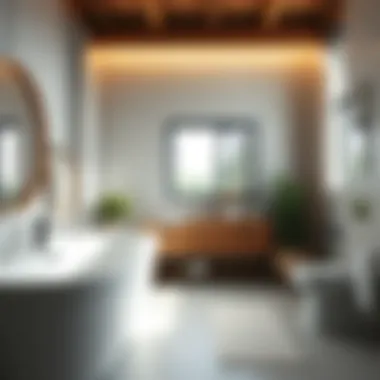
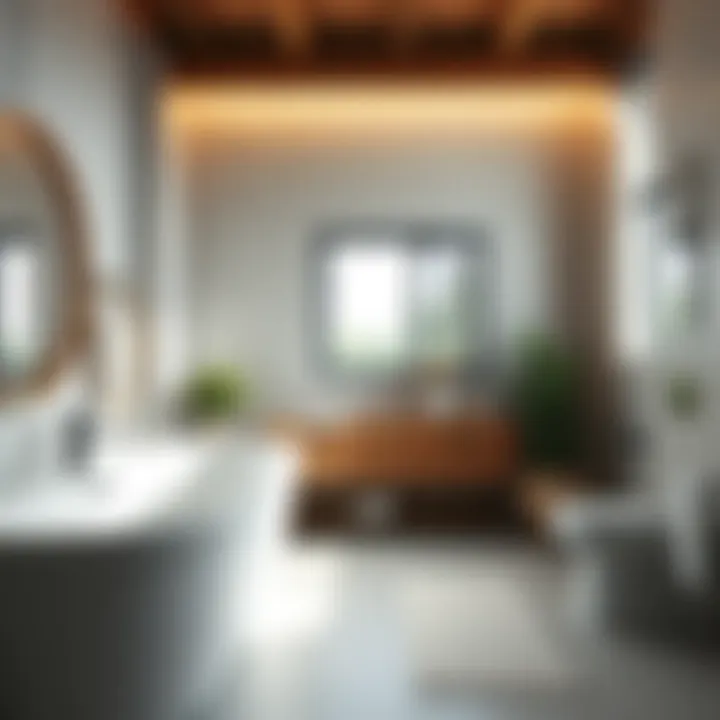
After nailing down the style, the next big leap is ensuring your bathroom layout is functional. Poorly designed spaces can quickly become a nuisance. Here are some essential aspects you must consider:
- Flow and Accessibility: Ensure that traffic flow is easy and unobstructed. For instance, placing the toilet too close to the sink can be uncomfortable. Plan enough room for someone to comfortably open cabinet doors or drawers, as well.
- Plumbing Considerations: Understanding existing plumbing lines can save you headaches down the road. Aligning new fixtures with current plumbing configurations can save on costs and minimize major work. It’s essential to think about where the pipework goes before committing to certain layouts.
- Zoning: Different zones can enhance usability. For instance, a separate area for the toilet could provide privacy while multiple people are in the bathroom. Also, consider integrating a small nook for storage to keep necessary items within reach without cluttering surfaces.
- Lighting and Ventilation: Don't overlook the importance of natural lighting and adequate ventilation in your layout. Generating a bright, airy atmosphere can uplift the whole room. Skylights or strategically placed windows can create an inviting ambiance.
Remember, a well-designed bathroom should facilitate ease of movement, enhance relaxation, and reflect your style. Investing time in design now can pay off immensely later!
Choosing Fixtures and Materials
Choosing the right fixtures and materials for your new bathroom can significantly influence not just the aesthetics but also the overall functionality of the space. This decision can be likened to picking the right tools for a chef in the kitchen; the wrong choice may lead to frustrations when trying to create a perfect meal. A bathroom isn’t just about appearance; it needs to be comfortable and practical. Every fixture, from sink to showerhead, contributes to the user experience and helps set the tone of the space.
Selecting Sink, Toilet, and Shower
When it comes to bathroom fixtures, the sink, toilet, and shower are the holy trinity of functionality. Each of them has a critical role that should not be underestimated.
- Sinks: The sink can be a focal point or a functional piece. Opting for a vessel sink can show off your flair for style. Meanwhile, a drop-in sink might be more practical depending on the countertop you've chosen. Think about how many people will use it. A double sink might be beneficial in busy households.
- Toilets: Don't underestimate the importance of the commode. A low-flow toilet, for instance, can save on water bills while being good for the planet. Look for options that are comfortable and easy to clean. You want something that does its job effectively without fuss.
- Showers: The choice of shower can make or break your daily routine. A luxurious rain shower might sound appealing, but consider if a traditional one might serve your needs better. It’s also essential to choose between a glass or a curtain enclosure. Glass can make a small bathroom feel more spacious, whereas a curtain might provide more flexibility.
A little research is beneficial here. You might find options you didn’t know existed. For instance, there’s a growing trend towards smart toilets that offer heated seats and even bidet functions. Explore the possibilities and get the best fit for your lifestyle.
"Choosing the right fixtures is key—it’s like the icing on the cake! If you get it wrong, it can spoil the whole experience."
Important Material Choices
The materials you select for your bathroom can determine the mood and durability of the space. Think beyond just aesthetic appeal; practicality and maintenance should be top of mind too.
- Countertops: Options such as granite or quartz not only look sleek but also resist stains and scratches. It’s essential to think about how much wear these surfaces will take.
- Flooring: Consider tile for its water resistance and variety in design. However, don’t overlook vinyl; it’s economical and can mimic other materials. You’ll want a flooring solution that can handle all those wet feet.
- Wall Treatments: Moisture-resistant paint is a must for walls, especially in spaces that will be humid. Tiles are another great choice for durability, but ensure they mesh well with the design you’re going for.
- Lighting Fixtures: This can’t be overlooked. You need proper illumination for practicality but also ambiance. Layer your lighting with overhead options paired with sconces to create a warm feel.
Choosing the right materials will pay dividends in the long run. Though some selections might come with a higher price tag, think about how often you'll need to replace cheaper options. Invest wisely and your bathroom can remain stunning for years to come.
Each decision you make brings you one step closer to a bathroom that reflects your personality and meets your needs. Don’t rush the selections. Have a clear idea of the overall look you want to achieve and don’t hesitate to consult with professionals when needed.
Hiring Professionals vs. DIY
When considering a bathroom addition, deciding whether to hire professionals or tackle the project yourself is a crucial step that can greatly affect the overall success and satisfaction of your renovation. Both options present their own distinct advantages and challenges, and understanding these can help you make an informed decision.
Weighing the Pros and Cons
The choice between hiring an expert and going DIY often comes down to several factors, including budget, skill level, and time availability. Here’s a closer look at what each approach entails:
Pros of Hiring Professionals
- Expertise: Professionals have the experience and training necessary to handle complex tasks safely.
- Time-Saving: Hiring a contractor means the work gets done much quicker than if you were to do it yourself.
- Quality Assurance: With professionals, you generally receive a level of workmanship that meets industry standards.
- Access to Resources: Experienced contractors know where to source materials and can often get wholesale pricing.
Cons of Hiring Professionals
- Cost: Contractors come with fees that dramatically increase the project's total price.
- Less Control: You may feel distanced from the project, relying on another's vision and schedule.
- Scheduling Conflicts: Professionals may have competing job commitments, delaying your project start and finish dates.
Pros of DIY
- Cost Efficiency: By doing it yourself, you save money on labor costs, which can be redirected to higher-quality materials or features.
- Creative Control: There’s a personal satisfaction in shaping every detail according to your vision and preferences.
- Flexibility: You work on your own timeline, making adjustments as your schedule allows.
Cons of DIY
- Skill Limitations: If you're not handy, required tasks may take longer or may not be done correctly, leading to costly mistakes.
- Time-Intensive: Expect to dedicate more time than anticipated, especially if you're learning as you go.
- Stress: The intricacies of plumbing and electrical work can create headaches for the inexperienced and lead to greater challenges throughout the project.
In summary, if you opt for the DIY route, you’ll need to weigh your available time and expertise against the potential for mistakes and setbacks. On the other hand, while hiring professionals means less hassle, it does come at a higher cost and may limit your creative input.
Finding Qualified Contractors
If you choose to go the professional route, selecting the right contractor is critical to the success of your bathroom addition. A capable professional not only alleviates stress but also ensures that your project meets all legal and aesthetic requirements.
Here’s how to find qualified people for the job:
- Research: Start with online platforms like Angie’s List or HomeAdvisor, where you can read reviews and compare ratings.
- Ask for Recommendations: Friends, family, or neighbors who have undergone similar renovations can steer you to trustworthy professionals.
- Verify Credentials: Always check licenses, insurance, and previous work portfolios to ensure that the contractor has a good standing.
- Obtain Multiple Quotes: Get estimates from various contractors, considering not just pricing but also project timelines and material recommendations.
- Conduct Interviews: Meet potential contractors to discuss your vision, gauge their enthusiasm and commitment, and review previous work.
"Taking the time to find the right contractor can save you a lot of heartaches down the road."
By evaluating your needs and carefully considering your options, embark on your bathroom addition journey equipped with both knowledge and resources that keep the project on course, whether you decide to roll up your sleeves or bring in the experts.
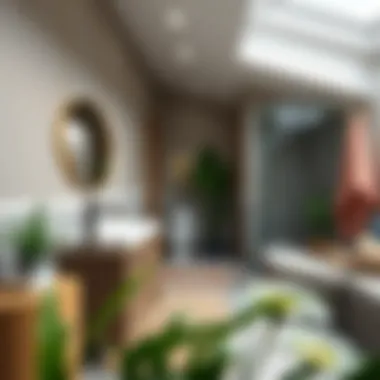

Construction Phase
The construction phase is where plans turn into reality. This is when the vision you’ve nurtured starts taking shape and, quite literally, changes your house's footprint. Homeowners often feel a mix of excitement and anxiety at this stage, and rightly so—it's a massive step toward enhancing both the functionality and value of your home. Understanding this phase thoroughly can pave the way for a smoother journey.
Timeline Expectations
In any construction project, especially with something as transformative as adding a bathroom, being on the same page regarding timelines is essential. Homeowners should get a realistic timeline from their contractor. This includes not just project duration but also major milestones.
The typical timeline for a bathroom addition can range from several weeks to a few months, depending on several factors:
- Design Complexity: A simple design will obviously take less time than one with intricate tile work or custom cabinetry.
- Permitting Process: As discussed earlier, local permits can delay work, often leaving you in limbo.
- Weather Conditions: If the addition requires outside work, inclement weather can also extend the timeline significantly.
- Contractor Schedule: The availability of hired professionals could impact start times and overall duration.
Understanding these elements allows you to plan around construction, minimizing inconvenience. Budgeting for unexpected delays or changes is prudent; it can prevent you from being caught off guard.
Minimizing Disruption to Your Home
Everyone knows construction can be messy, disruptive, and at times, downright inconvenient. However, there are ways to mitigate the chaos and irritation when a new bathroom is being built. Here are some strategies:
- Designate a Construction Area: Ensure that the workers know exactly where to put their tools and materials. This keeps other areas of your home accessible and less cluttered.
- Set Clear Communication: Regular check-ins with your contractor can help you stay updated on progress and any adjustments.
- Cover Important Furniture: Protect valuable or frequently used pieces with tarps or moving blankets.
- Create a Plan for Off-Limit Spaces: If possible, set up designated alternative spaces for use while construction is ongoing.
"A little foresight can save a whole heap of headaches down the road."
By planning ahead and putting some simple strategies into play, you'll find the construction phase more manageable. This allows you to enjoy and appreciate the journey to your new bathroom while minimizing disruptions to your daily life.
For more detailed guidance on home renovations, check out resources from your local building department or visit Home Advisor's Contractor Resources.
For additional reading on managing home construction timelines effectively, consider checking Builder Magazine.
In summary, the construction phase of adding a bathroom is a crucial element of your home improvement project. By understanding timelines and actively minimizing disruption, you can navigate this stage with greater ease.
Final Touches
Once the major construction is behind you, it’s time to delve into the delightful world of the final touches. This phase, often overlooked amid the chaos of renovation, is crucial for creating that cohesive, comfortable atmosphere in your new bathroom. Final touches aren’t just about aesthetics; they enhance functionality and elevate the overall experience. Paying close attention to each detail will transform your space into a sanctuary that combines beauty with practicality.
Installing Accessories and Decorations
Accessories and decorations are like the icing on the cake, giving your new bathroom its unique personality. Think of this as the moment to showcase your style and preferences. Here are some elements to consider:
- Lighting: Investing in good lighting is non-negotiable. Consider sconces, pendant lights, or even LED strips that highlight certain elements like mirrors or shelving. Varying light sources can create a more inviting atmosphere as well.
- Towels and Rugs: Fresh, plush towels and well-chosen rugs can add warmth and comfort. Opt for colors and patterns that complement your overall design while introducing a bit of texture.
- Artwork: Adding art can transform the feel of the room. Whether it’s a framed print or a stylish wall hanging, don’t shy away from making a statement. Just make sure the art can handle the humidity!
- Plants: Incorporating greenery can breathe life into the space. Consider low-maintenance plants like snake plants or pothos, which will thrive in a bathroom environment.
- Storage Solutions: Smart storage can act as a decoration itself. Shelving, baskets, and cabinets can help organize essentials while adding to the visual appeal. Think open shelves for displaying pretty bottles or decorative boxes for practicality.
By selecting accessories that align with your vision, you can create a bathroom that's not only functional but also inviting. It’s about crafting an overall feel that resonates with you.
Ensuring Proper Functionality
While aesthetics are important, ensuring that your bathroom functions smoothly is where you can’t afford to cut corners. Here are key considerations to keep in mind:
- Testing All Fixtures: Before you seal the deal on your renovation, test every faucet, showerhead, and toilet. Check for leaks, consistent water pressure, and ease of use. Nobody wants to deal with a stubborn faucet months down the line.
- Ventilation: Good ventilation is key to preventing mold and mildew. Make sure your exhaust fan is working properly and see if it’s appropriately sized for the space. No one enjoys a steamy bathroom, especially if it leads to long-term damage.
- Water Temperature Control: Ensure that you can easily control the water temperature for both the shower and sink. You want to prevent those sudden bursts of hot or cold water which can be downright jarring!
- Accessibility: Reflect on how accessible your bathroom is for all family members. Consider items like grab bars, non-slip mats, and even the height of fixtures. Making your bathroom user-friendly for everyone is a thoughtful touch.
By focusing on functionality with the same enthusiasm as you do for decor, you ensure that your beautiful new bathroom won’t just look good on Instagram—it’ll work its magic in the real world, too.
"The difference between a good bathroom and a great bathroom often lies in the details—the finishing touches that elevate the whole experience."
As you finalize these touches, take a step back and assess the overall harmony of your new space. Are the decorations and functionality working hand-in-hand? A little effort goes a long way, ensuring every visit to this sanctuary is a pleasure.
Maintenance Considerations
Adding a new bathroom is a significant investment. It can enhance your home’s value and improve functionality. However, the upkeep of that addition must not be overlooked. Regular maintenance not only ensures a pleasant appearance but also prolongs the life of your fixtures and avoids costly repairs down the line. Establishing a maintenance routine is not just about cleaning; it's about nurturing your space to keep it functioning efficiently.
Regular Upkeep Tips
To keep your bathroom in tip-top shape, consider these regular upkeep tips:
- Clean Regularly: A consistent cleaning schedule helps prevent mold and mildew. Focus on high-moisture areas like showers and under sinks.
- Check for Leaks: Regularly inspect faucets, toilets, and pipes for any signs of leaks. A small drip can lead to larger issues if left unchecked.
- Ventilation is Key: Ensure that your exhaust fan is working properly. It plays a major role in reducing moisture levels, preventing the chaotic growth of mold in the long run.
- Inspect Fixtures: Look out for wear and tear, like rust spots or chipped paint on fixtures, and address them promptly. A little bit of touch-up can go a long way.
These steps might seem simple, but they ensure your bathroom remains a functional, pleasant space.
Long-Term Care Strategies
Looking ahead, having a solid plan for long-term care of your bathroom can save you both time and money. Here are some strategies:
- Schedule Professional Inspections: At least once a year, hire a professional to inspect plumbing and electrical systems. They can spot potential problems before they snowball into major inconveniences.
- Upgrade Fixtures Thoughtfully: Consider updating fixtures every few years. New technologies often come with lower water usage, saving both the environment and your wallet.
- Protect Surfaces: Apply sealant to stone surfaces to protect against stains and damage. This can keep your surfaces looking pristine for years.
"A stitch in time saves nine"—a reminder that preventative maintenance is a wise investment in both your time and finances.
- Organize Regularly: Designate a time each month to organize and declutter your bathroom. An organized space can prevent chaos during your morning rush.
By integrating these long-term strategies into your routine, you cultivate a bathroom that remains both visually appealing and fully operational, allowing you to enjoy your home to the fullest.







